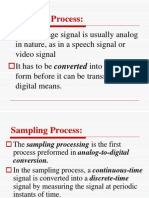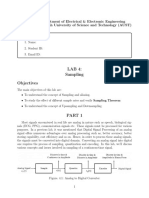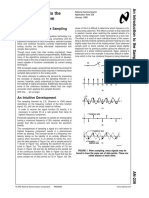Sampling Process
Uploaded by
Muhammad Salah ElgaboSampling Process
Uploaded by
Muhammad Salah ElgaboSampling Process:
The message signal is usually analog
in nature, as in a speech signal or
video signal
It has to be converted into digital
form before it can be transmitted by
digital means.
Sampling Process:
The sampling processing is the first
process performed in analog-to-digital
conversion.
In the sampling process, a continuous-time
signal is converted into a discrete-time
signal by measuring the signal at periodic
instants of time.
Sampling Process:
For the sampling process to be of
practical utility, it is necessary that we
choose the sampling rate properly
So the discrete-time resulting from
the process uniquely defines the
original continuous-time signal.
Sampling Theorem:
Let the signal
) (t x
be band limited with
bandwidth
W
i.e., let
0 ) ( f X . W f >
for
Let
) (t x be sampled at multiples of some
basic sampling interval
S
T , where
W
T
S
2
1
s
to yield the sequence
( ) | |
= n
S
nT x
Then it is
possible to reconstruct the original
Sampling Theorem:
signal ) (t x from the sampled values by the
reconstruction formula:
( ) ( )] 2 [ sin 2 ) (
S
n
S S
nT t W c nT x T W t x
' '
=
=
W
'
Where ( ) is any arbitrary number that
satisfies .
1
W
T
W W
S
s
'
s
Sampling Theorem:
special case where
W
T
S
2
1
=
the
reconstruction relation simplifies to:
=
=
(
|
.
|
\
|
|
.
|
\
|
=
|
|
.
|
\
|
=
n
S
n
S
W
n
t W c
W
n
x n
T
t
c nT x t x
2
2 sin
2
sin ) ( ) (
Prove of Sampling Theorem:
Then:
We can write
) (t x
o
as:
( ) ( ) ( )
S S
n
x t x nT t nT
o
o
=
=
=
=
n
S
nT t t x t x ) ( ) ( ) ( o
o
Let
) (t x
o
denote the result of the sampling
original signal by impulses at
S
nT
time instants.
Sampling Theorem:
Now if we find the Fourier transform of
both sides of the above relation and apply
the dual of the convolution theorem to the
right-hand side, we obtain:
( ) ( ) ( ) .....(4)
S
n
X f X f F t nT
o
o
=
(
= -
(
Sampling Theorem:
By using Fourier Transform we obtain:
(
= n
S
nT t F ) ( o
1
....(5)
n
S S
n
f
T T
o
=
| |
=
|
\ .
By substituting equation (5) into equation (4),
we obtain:
=
|
|
.
|
\
|
- =
n
S S
T
n
f
T
f X f X o
o
1
) ( ) (
=
|
|
.
|
\
|
=
n
S S
T
n
f X
T
1
Sampling Theorem:
Where in the last step we have employed the
convolution property of the impulse signal.
This relation shows that ) ( f X
o
, the Fourier
transform of the impulse-sampled signal is a
replication of the Fourier transform of the
original signal at a
S
T
1
rate.
Figure (1) shows this situation.
Sampling Theorem:
f
W -W -fs fs 0
. . . .
. . . .
s
f W
s o
f x
) ( f x
o
f
-W W
0
o
x
) ( f x
Figure (1):
Signal spectra for low pass sampling.
(a) Assumed spectrum for x(t).
(b) Spectrum of sampled signal.
Sampling Theorem:
Now if
W
T
S
2
1
> then the replicated spectrum of
) (t x
overlaps, and reconstruction of the original
is not possible.
This type of distortion results from under-
sampling is known as:
aliasing error or aliasing distortion.
Sampling Theorem:
However, if
W
T
S
2
1
s no overlap occurs, and by
employing an appropriate filter we can
reconstruct the original signal back.
To obtain the original signal back, it is
sufficient to filter the sampled signal by a low
pass filter with frequency response
Characteristic:
Sampling Theorem:
S
T f H = ) (
W f <
0 ) ( = f H
W
T
f
S
>
1
1.
for
.
2.
for
For
W
T
f W
S
< s
1
, the filter can have any
characteristics that make its implementation easy.
choice is an ideal low Of course, one obvious
pass filter with bandwidth
W
'
W
'
W
T
W W
S
<
'
s
1
where satisfies:
Sampling Theorem:
|
.
|
\
|
'
H =
W
f
T f H
S
2
) (
With this choice we have:
|
.
|
\
|
'
H =
W
f
T f X f X
S
2
) ( ) (
o
Taking inverse Fourier transform of both sides,
we obtain:
( ) t W c T W t x t x
S
' '
- = 2 sin 2 ) ( ) (
o
i.e.
Sampling Theorem:
( ) ( ) ( ) t W c T W nT t nT x
S
n
S S
' '
- |
.
|
\
|
=
=
2 sin 2 o
( ) ( ) | |
=
' '
=
n
S S S
nT t W c nT x T W 2 sin 2
This relation shows that if we use sine functions
for interpolation of the sampled values, we can
reconstruct the original signal perfectly.
Sampling Theorem:
The sampling rate
W
f
S
2
1
=
is the minimum
sampling rate at which no aliasing occurs.
This sampling rate is known as the Nyquist
sampling rate.
If sampling is done at the Nyquist rate,
then the only choice for the reconstruction
filter is an ideal low pass filter and .
2
1
S
T
W W = =
'
Sampling Theorem:
Then:
( )
=
|
.
|
\
|
=
n
n Wt c
W
n
x t x 2 sin
2
) (
( )
=
|
|
.
|
\
|
=
n
S
S
n
T
t
c nT x t x sin ) (
In practical systems, sampling is done at a rate
higher than the Nyquist rate.
This allows for the reconstruction filter to be
realizable and easier to build.
Sampling Theorem:
In such cases the distance between two adjacent
replicated spectra in the frequency domain; i.e.
W f W W
T
S
S
2
1
=
|
|
.
|
\
|
, is known as the guard band.
Problem 1
Problem 2
problem3
Problem 4
You might also like
- Porsche Digital Retail AV-Guideline en V2.10% (1)Porsche Digital Retail AV-Guideline en V2.1104 pages
- Signals and Systems: Lecture 13 Wednesday 6 December 2017No ratings yetSignals and Systems: Lecture 13 Wednesday 6 December 201734 pages
- Xu Ly Tin Hieu So Vo Trung Dung Handout 2 Dsp Lec 01 Sampling and Reconstruction [Cuuduongthancong.com]No ratings yetXu Ly Tin Hieu So Vo Trung Dung Handout 2 Dsp Lec 01 Sampling and Reconstruction [Cuuduongthancong.com]17 pages
- Sampling and Reconstruction DSP MaterialNo ratings yetSampling and Reconstruction DSP Material11 pages
- EEE358S Fundamentals of Communications EngineeringNo ratings yetEEE358S Fundamentals of Communications Engineering27 pages
- Aau/Aait Center of Biomedical Engineering Digital Signal ProcessingNo ratings yetAau/Aait Center of Biomedical Engineering Digital Signal Processing51 pages
- Sampling Theorem: g (t) - message signal sδ (t) - impulse pulse train gδ (t) - Sampled signalNo ratings yetSampling Theorem: g (t) - message signal sδ (t) - impulse pulse train gδ (t) - Sampled signal15 pages
- 16.36 Communication Systems Engineering: Mit OpencoursewareNo ratings yet16.36 Communication Systems Engineering: Mit Opencourseware16 pages
- An Introduction To The Sampling Theorem - AN236 (NAT)No ratings yetAn Introduction To The Sampling Theorem - AN236 (NAT)12 pages
- Lecture 13 - Sampling & Discrete SignalsNo ratings yetLecture 13 - Sampling & Discrete Signals5 pages
- Unit 4 Nyquist Sampling Theorem, Pulse AmplitudeNo ratings yetUnit 4 Nyquist Sampling Theorem, Pulse Amplitude40 pages
- Lecture+10-12 (Sampling and Reconstruction) PDFNo ratings yetLecture+10-12 (Sampling and Reconstruction) PDF72 pages
- Lecture #5, Fall 2003: ECE 6602 Digital CommunicationsNo ratings yetLecture #5, Fall 2003: ECE 6602 Digital Communications12 pages
- Application Note 236 An Introduction To The Sampling TheoremNo ratings yetApplication Note 236 An Introduction To The Sampling Theorem18 pages
- Unit 4 - Analog and Digital Communication - WWW - Rgpvnotes.inNo ratings yetUnit 4 - Analog and Digital Communication - WWW - Rgpvnotes.in23 pages
- Digital Signal and Image Processing using MATLAB, Volume 3: Advances and Applications, The Stochastic CaseFrom EverandDigital Signal and Image Processing using MATLAB, Volume 3: Advances and Applications, The Stochastic Case3/5 (1)
- Student Solutions Manual to Accompany Economic Dynamics in Discrete Time, secondeditionFrom EverandStudent Solutions Manual to Accompany Economic Dynamics in Discrete Time, secondedition4.5/5 (2)
- Noise: Any Unwanted Signal That Interfere With Wanted Signal Impair Communication System Degrade The System PerformanceNo ratings yetNoise: Any Unwanted Signal That Interfere With Wanted Signal Impair Communication System Degrade The System Performance45 pages
- Agenda: - AM Modulator Circuit. - AM Demodulator CircuitNo ratings yetAgenda: - AM Modulator Circuit. - AM Demodulator Circuit34 pages
- Double-Sideband Suppressed Carrier AM: - The Other Characteristic of The AmplitudeNo ratings yetDouble-Sideband Suppressed Carrier AM: - The Other Characteristic of The Amplitude19 pages
- 60-PREP-0005 Kornit Electrical Modular Curing System Site Preparation GuideNo ratings yet60-PREP-0005 Kornit Electrical Modular Curing System Site Preparation Guide20 pages
- Electronic & Telecommunication Engineering: Department ofNo ratings yetElectronic & Telecommunication Engineering: Department of30 pages
- Oscilador de TV Plasma Samsung MC34067P - MC33067PNo ratings yetOscilador de TV Plasma Samsung MC34067P - MC33067P17 pages
- BS en 62040.1.2-2003 - Uniterruptible Power SystemsNo ratings yetBS en 62040.1.2-2003 - Uniterruptible Power Systems5 pages
- Calibration Procedure For Melting Point Apparatus: IA 9100, 9200 and 9300No ratings yetCalibration Procedure For Melting Point Apparatus: IA 9100, 9200 and 93002 pages
- Power Board: Presence Bass Mids Treble Normal Bright StandbyNo ratings yetPower Board: Presence Bass Mids Treble Normal Bright Standby1 page
- n188 K8ak-Ls Conductive Level Controller Datasheet enNo ratings yetn188 K8ak-Ls Conductive Level Controller Datasheet en12 pages
- UNIT 3 Advanced Signals & Systems Questions and Answers - Sanfoundry PDFNo ratings yetUNIT 3 Advanced Signals & Systems Questions and Answers - Sanfoundry PDF5 pages
- 1 Introduction To Power System AnalysisNo ratings yet1 Introduction To Power System Analysis33 pages
- Fault Location in Extra Long HVDC Transmission LinNo ratings yetFault Location in Extra Long HVDC Transmission Lin8 pages
- Bs638 (Part 4) 0361Tq Welding Cable Single CoreNo ratings yetBs638 (Part 4) 0361Tq Welding Cable Single Core2 pages
- Exercise 2.1&2.2 Electric Current VoltageNo ratings yetExercise 2.1&2.2 Electric Current Voltage17 pages
- MODULE 2 - History of Computer: Basic Computer PeriodNo ratings yetMODULE 2 - History of Computer: Basic Computer Period23 pages
- Operating Instructions: MPPT Solar Charge Controller 10A - 20A - 30A Art. No. 200026 - 200027 - 200028No ratings yetOperating Instructions: MPPT Solar Charge Controller 10A - 20A - 30A Art. No. 200026 - 200027 - 2000285 pages
- Signals and Systems: Lecture 13 Wednesday 6 December 2017Signals and Systems: Lecture 13 Wednesday 6 December 2017
- Xu Ly Tin Hieu So Vo Trung Dung Handout 2 Dsp Lec 01 Sampling and Reconstruction [Cuuduongthancong.com]Xu Ly Tin Hieu So Vo Trung Dung Handout 2 Dsp Lec 01 Sampling and Reconstruction [Cuuduongthancong.com]
- EEE358S Fundamentals of Communications EngineeringEEE358S Fundamentals of Communications Engineering
- Aau/Aait Center of Biomedical Engineering Digital Signal ProcessingAau/Aait Center of Biomedical Engineering Digital Signal Processing
- Sampling Theorem: g (t) - message signal sδ (t) - impulse pulse train gδ (t) - Sampled signalSampling Theorem: g (t) - message signal sδ (t) - impulse pulse train gδ (t) - Sampled signal
- 16.36 Communication Systems Engineering: Mit Opencourseware16.36 Communication Systems Engineering: Mit Opencourseware
- An Introduction To The Sampling Theorem - AN236 (NAT)An Introduction To The Sampling Theorem - AN236 (NAT)
- Lecture #5, Fall 2003: ECE 6602 Digital CommunicationsLecture #5, Fall 2003: ECE 6602 Digital Communications
- Application Note 236 An Introduction To The Sampling TheoremApplication Note 236 An Introduction To The Sampling Theorem
- Unit 4 - Analog and Digital Communication - WWW - Rgpvnotes.inUnit 4 - Analog and Digital Communication - WWW - Rgpvnotes.in
- Digital Signal and Image Processing using MATLAB, Volume 3: Advances and Applications, The Stochastic CaseFrom EverandDigital Signal and Image Processing using MATLAB, Volume 3: Advances and Applications, The Stochastic Case
- Student Solutions Manual to Accompany Economic Dynamics in Discrete Time, secondeditionFrom EverandStudent Solutions Manual to Accompany Economic Dynamics in Discrete Time, secondedition
- Noise: Any Unwanted Signal That Interfere With Wanted Signal Impair Communication System Degrade The System PerformanceNoise: Any Unwanted Signal That Interfere With Wanted Signal Impair Communication System Degrade The System Performance
- Agenda: - AM Modulator Circuit. - AM Demodulator CircuitAgenda: - AM Modulator Circuit. - AM Demodulator Circuit
- Double-Sideband Suppressed Carrier AM: - The Other Characteristic of The AmplitudeDouble-Sideband Suppressed Carrier AM: - The Other Characteristic of The Amplitude
- 60-PREP-0005 Kornit Electrical Modular Curing System Site Preparation Guide60-PREP-0005 Kornit Electrical Modular Curing System Site Preparation Guide
- Electronic & Telecommunication Engineering: Department ofElectronic & Telecommunication Engineering: Department of
- Oscilador de TV Plasma Samsung MC34067P - MC33067POscilador de TV Plasma Samsung MC34067P - MC33067P
- BS en 62040.1.2-2003 - Uniterruptible Power SystemsBS en 62040.1.2-2003 - Uniterruptible Power Systems
- Calibration Procedure For Melting Point Apparatus: IA 9100, 9200 and 9300Calibration Procedure For Melting Point Apparatus: IA 9100, 9200 and 9300
- Power Board: Presence Bass Mids Treble Normal Bright StandbyPower Board: Presence Bass Mids Treble Normal Bright Standby
- n188 K8ak-Ls Conductive Level Controller Datasheet enn188 K8ak-Ls Conductive Level Controller Datasheet en
- UNIT 3 Advanced Signals & Systems Questions and Answers - Sanfoundry PDFUNIT 3 Advanced Signals & Systems Questions and Answers - Sanfoundry PDF
- Fault Location in Extra Long HVDC Transmission LinFault Location in Extra Long HVDC Transmission Lin
- MODULE 2 - History of Computer: Basic Computer PeriodMODULE 2 - History of Computer: Basic Computer Period
- Operating Instructions: MPPT Solar Charge Controller 10A - 20A - 30A Art. No. 200026 - 200027 - 200028Operating Instructions: MPPT Solar Charge Controller 10A - 20A - 30A Art. No. 200026 - 200027 - 200028































































































